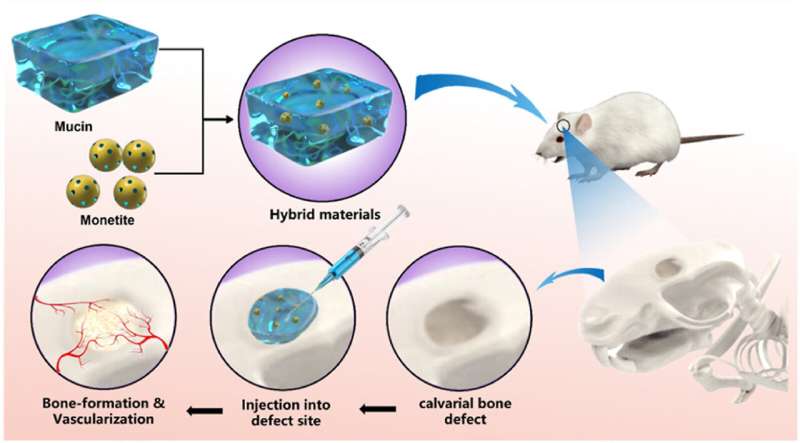This article has been reviewed according to Science X's editorial process and policies. Editors have highlighted the following attributes while ensuring the content's credibility:
fact-checked
trusted source
proofread
Mucus-based gel improves bone graft results and promotes healing

Molecules from mucus can be used to produce synthetic bone graft material and help with the healing of larger bone loss, a new study found.
Researchers at KTH Royal Institute of Technology report the development of a bioactive gel which they say could replace the clinical gold standard of autografting, in which lost bone is replaced with healthy bone taken from another part of the patient's body.
Hongji Yan, a researcher at KTH Royal Institute of Technology, says the gel contains mucins, molecules which were derived from cow mucus. The mucins are processed into gels which are combined with monetite granules, a commonly-used synthetic bone graft material. The synthetic gel can be injected to the site of the bone loss.
In tests on lab rats with cranial injuries, researchers found that this biomaterial can help solve two key requirements for successful healing of bone defects. It promotes formation of bone and blood vessels and it interacts with the immune system. The results were published in the scientific journal Bioactive Materials.
As the main solid components of mucus, mucins give mucus its viscosity, and can balance the reaction of the immune system. Mucins can for example modulate immune cells and mitigate inflammation. But Yan says this is the first study to show how these qualities work with tissue repair.
Bodily tissue is loaded with blood vessels and bones are no exception. When bone defects are on the mend, newly formed bone needs to be engulfed into the host bone's vasculature—that network of blood vessels that connect the new bone to the heart.
Yan says the research raises hopes for better outcomes in a wide range of procedures for treating larger bone loss.
"Mucus protects the body from invaders such as bacteria and viruses, and maintains hemostasis in tissues, where mucins play an important role," Yan says. "The regenerative approach, using the body's own cells through synthetic active material, offers a way to promote bone healing.
"Grafting from a patient's own bone tissue has limits. There may be an inadequate supply of healthy tissue, and it can be especially risky for people with poor bone quality such as the elderly," he says.
The material is however not ready for clinical use, and further studies with larger animals are planned by the research group.
More information: Song Chen et al, Early osteoimmunomodulation by mucin hydrogels augments the healing and revascularization of rat critical-size calvarial bone defects, Bioactive Materials (2023). DOI: 10.1016/j.bioactmat.2023.01.022




















